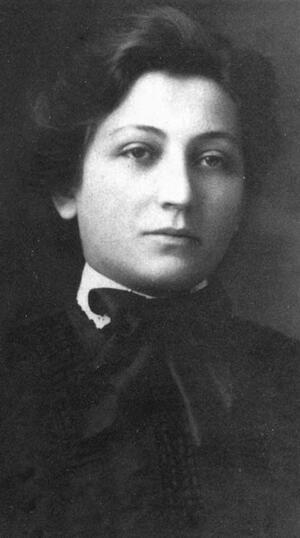Bessie Abramowitz Hillman
Bas Sheva Abramowitz (“Bessie” was created by an Ellis Island immigration officer) was born in 1889, in Linoveh, Russia, one of ten children. In 1905, Bessie—eager to avoid marriage—joined an older cousin in immigrating to America.
Arriving in Chicago, where she had some distant relatives, the 15-year-old found a job as a button sewer in a garment factory and enrolled in night school at Hull House, a local Settlement House servicing the immigrant community. When she organized a shop committee to protest working conditions and pay of three dollars for a 60-hour week, she was fired. Looking for other work, she found herself on an employers’ blacklist and was finally forced to take a job under an assumed name.
In September 1910, the 20-year-old rebel again fought back, now against a pay cut. She led a walkout of 16 young women, an outburst at first viewed with amusement by most other workers in the plant, including Sidney Hillman, a 24-year-old Lithuanian-born cutter. As the young women persisted, however, they gained followers, and by mid-October most of the 8,000 workers at the Hart, Shaffner, and Marx firm were out on strike, soon joined by thousands in other plants. Sidney Hillman, too, followed the lead of the young women, joining the strike three weeks after its initiation and soon emerging as a strike leader. The strike won the support of Jane Addams of Hull House and its Women’s Trade Union League, which hired Bessie Abramowitz as an organizer.
On the union barricades, Bessie and Sidney’s friendship blossomed into a romance, and they were secretly engaged in 1914. Since both were sending money back to their families, an immediate marriage seemed impossible in a time period where most wives didn’t work. In late 1914, garment workers in Chicago, New York, and other clothing centers split from the conservative United Garment Workers to form the Amalgamated Clothing Workers of America, and Bessie Abramowitz was elected to its general executive board. She became a leader in the campaign to draft Sidney Hillman to be president of the new union. He accepted and, during 1915, the young couple again fought together in an industry-wide strike for the union shop.
Bessie and Sidney announced their engagement publicly by marching arm-in-arm in the clothing workers’ contingent in the Chicago May Day parade of 1916. They were married a few days later and soon moved to New York City, headquarters of the new union. From then until 1946, when Sidney Hillman died, all of Bessie Hillman’s considerable union work was performed as an unpaid volunteer.
Hillman gave birth to two daughters and continued to do Women’s Trade Union League volunteer work at home until she returned to active union work in. She organized workers in Pennsylvania, Ohio, upstate New York, Connecticut, and elsewhere.
In 1937, Bessie Hillman became education director of the Laundry Workers Joint Board, emphasizing cultural programs, as well as union leadership education. In the Laundry Workers, a union with many nonwhite workers, Bessie Hillman became strongly involved in civil rights work, a dominant concern for the rest of her life. During World War II, Bessie Hillman helped lead the union’s war efforts.
The Hillmans’ home life was determinedly secular, yet the Hillmans were firm in identifying as Jews. They spoke Yiddish at home and Jewish holidays were observed as family celebrations. When Jews, including some of Bessie Hillman’s brothers and sisters, fell victim to the Holocaust, the Hillmans protested vigorously, supporting the war effort in the 1940s as part of their fight against the Nazi campaign to wipe out Jews. In 1947, Bessie Hillman traveled to Europe on a union-sponsored mission to examine the problems of displaced persons.
When Sidney Hillman died in 1946, he left virtually no money. The Amalgamated hired Bessie Hillman as a paid vice president in charge of the union’s education programs. She spoke at union conferences, helped organize summer schools for rank-and-file leaders, and urged the union to greater efforts for civil rights, peace, and economic justice.
Over the years, Bessie Hillman served in many organizations, including the CIO and AFL-CIO Civil Rights Committees, the National Consumers League, the American Labor Education Service, Inc., the Child Welfare Committee of New York, and the Defense Advisory Commission on Women in the Services. She was appointed by President John F. Kennedy to the President’s Commission on the Status of Women.
Bessie Abramowitz Hillman remained active in union activities until her death in New York City, in December 1970, at age eighty-one.
This biography is adapted from Antonio Ramirez’s article on Bessie Abramowitz Hillman in Jewish Women: A Comprehensive Historical Encyclopedia.



